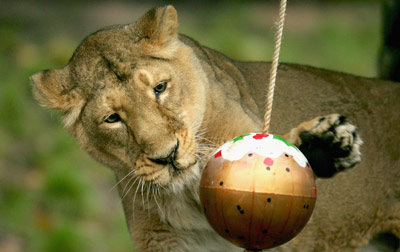 Zoo Pros: Education, Conservation, Entertainment Zoos have improved significantly in the last 4,000 or so years. Gone are the old steel-bar enclosures and cold cement cages. Most zoos these days use natural-looking barriers like moats or ditches to separate animals from people, and have mini-habitats that resemble the animals' natural environment. Adding another point for zoo pros, the procedure for acquiring animals has also changed. Whereas zoos previously captured most of their specimens directly from the wild, they now get many animals through captive breeding programs and other zoos. Some breeding programs also help to restore threatened species. After 10 years of working to strengthen the population numbers of the endangered California condor, a type of vulture, the Los Angeles and San Diego zoos were able to rebuild a population of fewer than two dozen birds to around 170 birds [source: Encarta]. Successful breeding programs brought the Pere David's deer back from extinction. Though this Asian deer ceased to exist in the wild, Chinese and European zoo programs enabled four of the deer to be released back into the wild in 1985, where they're now self-sustaining [source: Encarta]. Some zoos also take in abandoned animals that wouldn't otherwise have a home. Both the Baltimore Zoo and the Detroit Zoo have taken in polar bears rescued from a traveling circus, and the Bronx Zoo took in an orphaned snow leopard from Pakistan in 2007. The cub, Leo, now spends his time frolicking and chasing small animals that wander into his enclosure [source: Majkowski]. And although zoo animals aren't treated quite like guests at a four-star hotel, their care has improved tremendously. Zookeepers now understand that many animals, such as monkeys, bears and elephants, need engaging activities to prevent boredom and mental deterioration. This is why you'll often see chimps playing with toys or tigers "hunting" for a meal. Aside from taking care of captive animals, many zoos also contribute to the care of their wild counterparts. The Toledo Zoo, in conjunction with the Nature Conservancy, is helping to restore butterfly habitats in Ohio, and the Bronx Zoo has channeled more than $3 million toward conservation projects in central Africa [source: Fravel]. Zoos also present an opportunity for scientists to conduct research. In 2002, zoos participated in 2,230 research and conservation projects in more than 80 countries. The information they gather helps them to develop new medicines and techniques to improve animal health [source: Fravel]. Beyond the positive impact zoos try to have on animals, they often affect the people visiting as well. Zoos don't just entertain, they also aim to educate. With a variety of programs geared toward children and adults, zoos teach people about the needs of animals and the importance of conservation. And if people get excited enough, the thinking goes that they'll be more inclined to donate money to conservation efforts -- another zoo pro. The fact that zoos impact people in a positive way is nice, but it's not the people critics worry about -- it's the animals.
0 Comments
Can you design and engineer an instrument for a class orchestra?
The Life Story of George Washington CarverHome Connection |
Important WebsitesFirst Grade Code.org Categories
All
Archives
May 2019
|


 RSS Feed
RSS Feed
